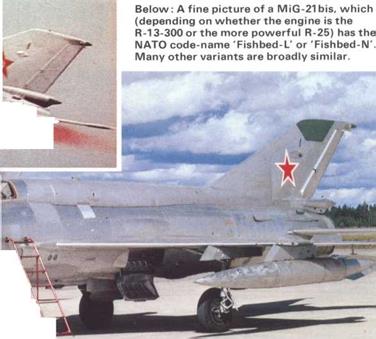Mikoyan/Gurevich MiG-21
MiG-21, 21 F (S-107), 21 FA, 21 PF, 21 FL,
21 PFS, 21 PFM, 21 PFMA, 21 M, 21 R,
21 MF, 21SMT, 21 bis, 21 U, 21 US and 21 UM plus countless special versions. Several versions made in China as F-8
Origin: The design bureau named for Mikoyan and Gurevich: Soviet Union: licence-production as described in the text.
Type: Single-seat fighter: (PFMA and MF) limited all-weather multi-role: (R) reconnaissance: (U) two-seat trainer.
Engine: In all versions, one Tumansky single-shaft turbojet with afterburner: (-21) R-11 rated at 11,2401b (5100kg) with afterburner: (-21 F) R-11-F2-300 rated at 13,1201b (5950kg): (-21 FL, PFS, PFM and PFMA) R-11-G2S-300 rated at 13,6681b (6200kg): (-21 MF and derivatives) R-13-300 rated at 14,5001b (6600kg).
Dimensions: Span 23ft 5jin (7-15m): length (excluding probe) (-21) 46ft 11 in: (-21 MF) 48ft OJin (14-6m): height (little variation, but figure for MF) 14ft 9in (4’5m).
Weights: Empty (-21) 11,4641b (5200kg): (-21 MF) 12,3461b (5600kg): maximum loaded (-21) 18,7401b (8500kg): (-21 MF) 21,6051b (9800kg) (weight with three tanks and two K-1 ЗА, 20.725lb).
Performance: Maximum speed (MF, but typical of all) 1,285mph (2070km/h, Mach 2-1): initial climb (MF, clean) 36,090ft (11,000m)/min: service ceiling 59,050ft (18,000m): range (high, internal fuel) 683 miles (1100km): maximum range (MF, high, three tanks) 1,118 miles (1800km). Armament: See text.

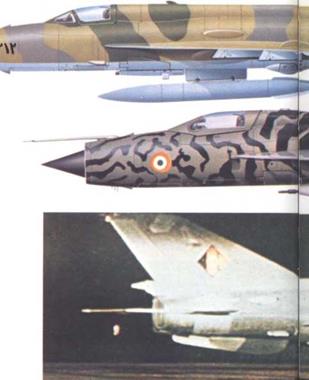 Right: An early model, MiG-21 FL, on night-flying practice with the East German (LSK) air force. This sub-type is not equipped for night fighting, though with good ground guidance it might get into a firing position.
Right: An early model, MiG-21 FL, on night-flying practice with the East German (LSK) air force. This sub-type is not equipped for night fighting, though with good ground guidance it might get into a firing position.
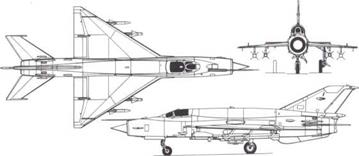 |
Above: Three-view of MiG-21 SMT ("Fishbed K") with four K-1 ЗА missiles.
History: First flight (E-5 prototype) late 1955: (production -21F) late 1957: service delivery early 1 958.
Users: Afghanistan, Albania, Algeria, Angola, Bangladesh, Bulgaria, China, Cuba, Czechoslovakia, Egypt, Ethiopia, Finland, E Germany, Flungary, India (licence-built), Indonesia (stored), Iraq, Laos, Mozambique, Nigeria,
N Korea, Poland, Romania, Somalia, Soviet Union, Sudan, S Yemen, Syria, Tanzania, Uganda, Vietnam, Yemen Arab Republic, Yugoslavia.
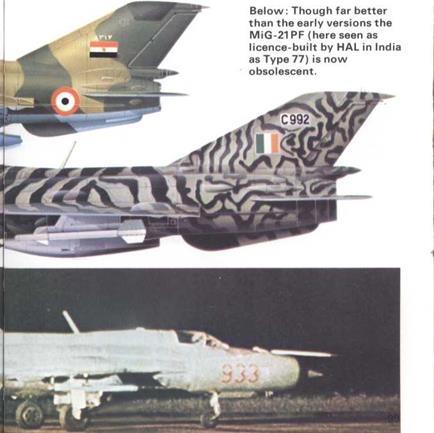
Development: Undoubtedly the most widely used combat aircraft in the world in the 1970s, this trim little delta has destablished a reputation for cost effectiveness and in its later versions it also packs a more adequate ►
multi-role punch. It was designed in the 18 months following the Korean War. While Sukhoi developed large supersonic fighters to rival the American F-100, the Mikoyan-Gurevich bureau, by now led only by Col-Gen Mikoyan (who died in 1970), concentrated on a small day interceptor of the highest possible performance. Prototypes were built with both swept and delta wings, both having powered slab tailplanes, and the delta was chosen for production. At least 30 pre-production aircraft had flown by the time service delivery started and the development effort was obviously considerable. The initial MiG-21 abounded in interesting features including Fowler flaps, fully powered controls, upward ejection seat fixed to the rear of the front-hinged canopy (which incorporated the whole front of the cockpit enclosure except the bullet-proof windshield) to act as a pilot blast-shield, and internal fuel capacity of only 410 gal. Armament was two 30mm NR-30 in long fairings under the fuselage, the left gun usually being replaced by avionics. Part of these avionics serve the two K-13 ("Atoll") missiles carried on wing pylons on the slightly more powerful 21 F. This had radar ranging, 515 gal fuel, broader fin, upward-hinged pitot boom attached under the nose (to prevent people walking into it) and two dorsal blade aerials. Czech-built aircraft (still called 21 F) did not have the rear-view windows in the front of the dorsal spine. The F was called "Fishbed C" by NATO and Type 74 by the Indian Air Force; it was also the type supplied to China in 1 959 and used as the pattern for the Chinese-built F-8. As the oldest active variant it was also the first exported or seen in the West, the Finnish AF receiving the 21 F-1 2 in April 1963.
At Tushino in 1961 the prototype was displayed of what became the 21 PF, with inlet diameter increased from 27in to 36in, completely changing the nose shape and providing room for a large movable centre-body housing the scanner of the R1 L (NATO "Spin Scan") Al radar. Other changes include deletion of guns (allowing simpler forward airbrakes), bigger main – wheels (causing large fuselage bulges above the wing), pitot boom moved above the inlet, fatter dorsal spine (partly responsible for fuel capacity of 627gal) and many electronic changes. All PF had an uprated engine, late models had take-off rocket latches and final batches had completely new
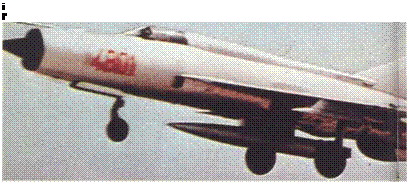 |
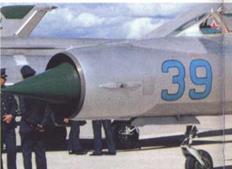 Above: Though the latest type of combat aircraft so far permitted to the air force of Romania is the very limited MiG-21 PF, with ‘AA-2 Atoll’ IR-homing missiles, it is possible that an air-combat version of the Orao may appear. About 80 of all MiG-21 versions are believed to be in service with this country.
Above: Though the latest type of combat aircraft so far permitted to the air force of Romania is the very limited MiG-21 PF, with ‘AA-2 Atoll’ IR-homing missiles, it is possible that an air-combat version of the Orao may appear. About 80 of all MiG-21 versions are believed to be in service with this country.
blown flaps (SPS) which cut landing speed by 25mph and reduced nose-up attitude for better pilot view. The FL was the export – PF (L = lokator. denoting R2L radar) with even more powerful engine. Like the F models rebuilt in 1963-64, this can carry the GP-9 gunpack housing the excellent GSh-23 23mm twin-barrel gun, has a still further broadened vertical tail and drag – chute repositioned above the jetpipe. The PFS was the PF with SPS blown flaps, while the PFM was a definitive improved version with another 19in added to the fin (final fillet eliminated), a conventional seat and side-hinged canopy, and large flush aerials in the fin. One-off versions were built to prove STOL with lift jets and to fly a scaled "analogue" of the wing of the Tu-144 SST. The very important PFMA. made in huge numbers, was the first multirole version, with straight top line from much deeper spine (housing equipment and not fuel and holding tankage to 572gal), and four pylons for two 1,1001b and two 5511b bombs, four S-24 missiles and/or tanks or K-1 ЗА missiles. The 21M has an internal GSh-23 and since 1973 has been built in India as Type 88. The 21 R has multi-sensor reconnaissance internally and in pods and wing-tip ECM fairings, as do late models of the 21 MF, the first to have the new R-13 engine. The RF is the R-1 3-powered reconnaissance version. One of the few variants still in production is the SMT, with fuel restored to the spine and more comprehensive avionics including tail-warning radar.
Code-named "Mongol" and called Type 66 in India, the U is the tandem trainer, the US has SPS flaps and UM the R-13 engine and four pylons. Many other versions have been used to set world records. About 10,000 of all sub-types have been built, and in 1977 output was continuing at perhaps three per week in the Soviet Union, with a much lower rate, in India; in early 1976 N Korea was said to be also in production. Many of the early models of this neat fighter were sweet to handle and quite effective day dogfighters, but the majority of the subtypes in use have many adverse characteristics and severe limitations.
In late 1976 a new version appeared, the MiG-21 bis (Fishbed L); this is a cleaned-up and refined MiG-21 MF with Tacan-type navigation and other improvements.
|
|











